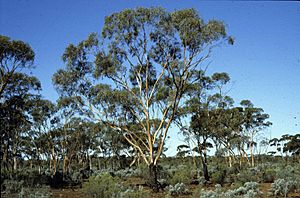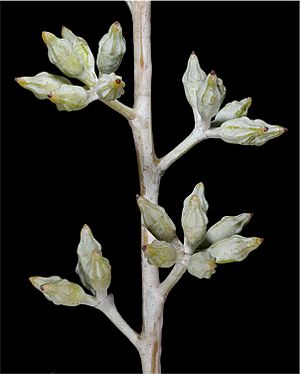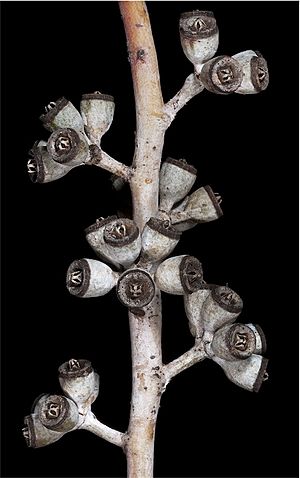Cleland's blackbutt facts for kids
Quick facts for kids Cleland's blackbutt |
|
|---|---|
 |
|
| Eucalyptus clelandiorum growing north of Kalgoorlie | |
| Scientific classification | |
| Genus: |
Eucalyptus
|
| Species: |
clelandiorum
|
| Synonyms | |
|
|
Eucalyptus clelandiorum, commonly known as Cleland's blackbutt, is a special type of tree. It's a "mallet," which means it's a tree that doesn't grow a big woody base called a lignotuber. This tree is only found in the South West part of Western Australia.
It has unique bark: hard, black, and crumbly on the bottom half of its trunk. The bark higher up is smooth. Its adult leaves are long and narrow, shaped like a spear. The flower buds grow in groups of seven, nine, or eleven. When they open, the flowers are white. After flowering, the tree produces fruit that looks like a small cup.
Contents
What Does Cleland's Blackbutt Look Like?
Cleland's blackbutt is a type of tree called a mallet. It usually grows up to 10 m (33 ft) tall. This tree does not form a lignotuber, which is a woody swelling at the base of some plants.
The bark on the lower half of the trunk is hard, black, and crumbly. Above that, the bark is smooth and can be pale grey or pinkish.
Leaves and Buds
Young plants and new shoots have leaves that are a bit waxy or "glaucous." They are broad and egg-shaped, up to 80 mm (3.1 in) long and 35 mm (1.4 in) wide.
Adult leaves are a dull greyish-green or glaucous on both sides. They are narrow and spear-shaped, measuring 80–155 mm (3.1–6.1 in) long and 9–25 mm (0.35–0.98 in) wide.
The flower buds grow in groups of seven, nine, or eleven. These groups are found where the leaves meet the stem, on a stalk called a peduncle. This stalk is 6–15 mm (0.24–0.59 in) long. Each individual bud sits on a smaller stalk called a pedicel, which is 1–5 mm (0.039–0.197 in) long.
Mature buds are oval-shaped, 7–12 mm (0.28–0.47 in) long and 4–7 mm (0.16–0.28 in) wide. They are also waxy or glaucous. Each bud has a beak-shaped cap, called an operculum, which is 4–6 mm (0.16–0.24 in) long.
Flowers and Fruit
Cleland's blackbutt mainly flowers from August to November. Its flowers are white.
The fruit is a woody, cup-shaped capsule. It is 5–9 mm (0.20–0.35 in) long and 5–8 mm (0.20–0.31 in) wide. Each fruit sits on a pedicel that is 1–6 mm (0.039–0.236 in) long.
How Was Cleland's Blackbutt Named?
Cleland's blackbutt was first officially described in 1911 by a botanist named Joseph Maiden. He first called it Eucalyptus goniantha var. clelandiorum. He published this description in a science journal.
In 1912, Maiden decided that this plant was unique enough to be its own species. So, he changed its name to Eucalyptus clelandiorum in his book about Eucalyptus trees.
The specific part of the name, clelandiorum, honors two people: Mr. A.F. Cleland, who was a Civil Engineer, and his nephew, Dr. J. Burton Cleland. Even though Maiden first wrote the name as Eucalyptus clelandi, it was later corrected to Eucalyptus clelandiorum. This correction followed the rules for naming plants, to show that it honored two men, not just one.
Where Does Cleland's Blackbutt Grow?
Eucalyptus clelandiorum mostly grows in open woodlands. You can find it from east of Cue to near Lake Biddy. It grows in several different natural areas of Western Australia, including the Avon Wheatbelt, Coolgardie, Great Victoria Desert, Murchison, and Yalgoo regions.
Is Cleland's Blackbutt Endangered?
The Western Australian Government's Department of Parks and Wildlife has classified this tree as "not threatened." This means it is not currently at risk of disappearing.



